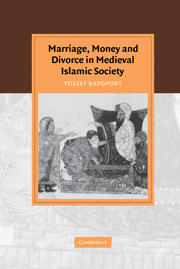Book contents
- Frontmatter
- Contents
- Acknowledgments
- Glossary
- List of abbreviations
- Introduction
- Chapter 1 Marriage, divorce and the gender division of property
- Chapter 2 Working women, single women and the rise of the female ribāṭ
- Chapter 3 The monetization of marriage
- Chapter 4 Divorce, repudiation and settlement
- Chapter 5 Repudiation and public power
- Conclusion
- Bibliography
- Index
- Cambridge Studies in Islamic Civilization
Chapter 4 - Divorce, repudiation and settlement
Published online by Cambridge University Press: 15 June 2009
- Frontmatter
- Contents
- Acknowledgments
- Glossary
- List of abbreviations
- Introduction
- Chapter 1 Marriage, divorce and the gender division of property
- Chapter 2 Working women, single women and the rise of the female ribāṭ
- Chapter 3 The monetization of marriage
- Chapter 4 Divorce, repudiation and settlement
- Chapter 5 Repudiation and public power
- Conclusion
- Bibliography
- Index
- Cambridge Studies in Islamic Civilization
Summary
The basic inequality of Islamic law, whereby a husband can pronounce a unilateral repudiation while a wife needs either the husband's consent for divorce or the intervention of the courts, has been one of the major sources of husbands' power in marriage. The absolute right of husbands to disband the marriage contract at will, like the absolute right of a master to manumit his slave, were symbols of patriarchal authority, eclipsing other male privileges, such as polygamy, concubinage and the right of physical chastisement. It was also the ultimate threat against an insolent wife. The prevailing cultural assumption in Mamluk society, at least until the end of the fifteenth century, was that divorce was a disaster for women. It deprived them of support and protection; and if they remarried, the application of Islamic law meant that they were in danger of losing custody of their children.
A wife who wanted a divorce had limited legal tools. One option was to insert clauses in the marriage contract that would allow her to choose a divorce in the event of her husband taking another wife or a concubine, beating her or failing to sustain her. If such clauses were not inserted, judicial divorces were granted only in cases of desertion. The qāḍīs, ostensibly the protectors of women, were generally reluctant to intrude more assertively in the domestic sphere, where the word of the husband was supposed to reign supreme.
- Type
- Chapter
- Information
- Marriage, Money and Divorce in Medieval Islamic Society , pp. 69 - 88Publisher: Cambridge University PressPrint publication year: 2005
- 1
- Cited by



